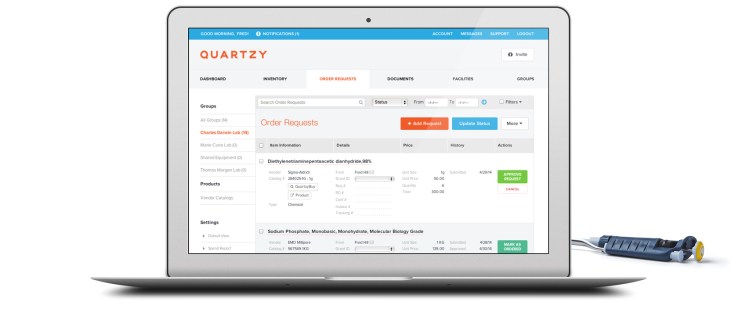Quartzy is a lab supplies marketplace often used among life scientists at various universities, but particularly at Stanford. The academic institution made that relationship official today. Quartzy will now be deployed in labs across the Stanford campus to save the university cash on lab supplies.
The Quartzy marketplace launched out of Y Combinator four years back to provide an easier way for scientists to price-compare life science tools and equipment. Co-founders Adam Regelmann and Jayant Kulkarni met while conducting their own lab research at Columbia University. The two noticed a lack of supply-chain and management tools to make the lab process more efficient.
Quartzy uses a bidding platform to help scientists find less expensive products from competing suppliers. The startup also provides lab-management tools that aim to make new orders easy when supplies get low.

It also helps labs avoid sticky regulations. The United States federal government requires two quotes for items that cost more than $3,000. The Quartzy bidding platform automatically generates competitive quotes from multiple suppliers that will hopefully save labs money without wasting time getting those quotes.
Quartzy believes it can save Stanford $15 million out of a $100 million estimated annual lab supplies spend with the new partnership. However, the startup won’t make money on saving money for the academic institution. Instead, suppliers pay a commission to Quartzy on products purchased. Commissions are the same rate for each supplier so there isn’t a bias for certain suppliers over others, according to Kulkarni.
There isn’t much competition in the space, either. Science Exchange helps labs save money by providing outsourcing of the experiments rather than tools for your own lab use. HappiLabs provides price comparison for lab supplies as well, but charges for the “lab shopping consultants” starting at $250 per month.
More than 10,000 labs and many major academic institutions now use the price-comparison service to save, including Duke, Harvard, MIT and now campus-wide at Stanford.
“We expect to reach critical mass on the supplier-side with this addition of demand generated by Stanford,” Kulkarni told TechCrunch. “This will make the platform and the marketplace more valuable to other labs and jump-start our adoption at other large institutions across the U.S.”
